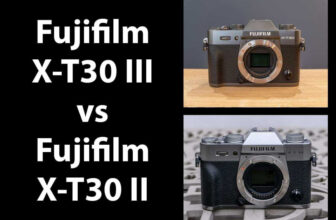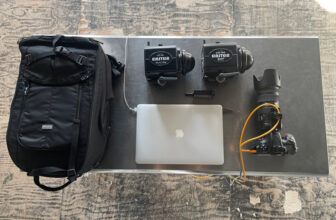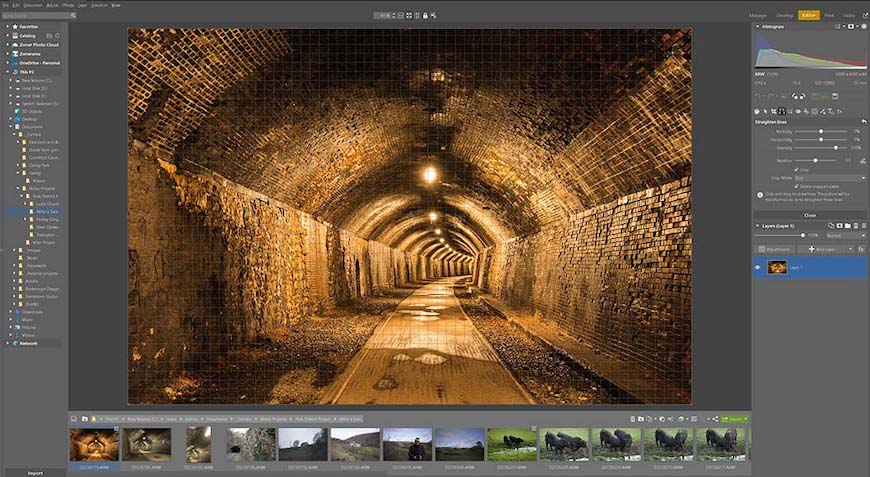
This Zoner Studio review will break down everything you need to know about the photo editing software.
With its broad suite of tools covering everything from file management to RAW file and video editing, Zoner Studio promises outstanding versatility.
Its latest iteration has introduced a host of powerful AI-based tools that further elevate it as a highly recommended platform.
I’ve put it through its paces to see if it delivers the flexibility and performance contemporary photographers demand.
Let’s take a look.
Highly Recommended
Photo organizer and editor with powerful editing tools, a user-friendly interface, and video editing capabilities.
What is Zoner Studio?
Formerly known as Zoner Photo Studio X, Zoner Studio has been gaining traction in the photography community in recent years.
While both Lightroom and Photoshop are household names, Zoner Studio has often crept under the radar when it comes to optimal photo editing tools.
The company has been developing software, such as the Zoner Studio range, since the early 1990s, garnering numerous awards over the years.
Their latest iteration boasts numerous enhancements, making it a compelling alternative to Adobe’s flagship software.
The platform combines many of the features required for a complete and professional photo management, editing, and exporting workflow.
This includes a development module for image processing, an editor module covering Photoshop-like processes, and even a video module.
More recently, the software has been updated to include a wealth of AI-powered tools that were lacking in previous builds.
The developers have also introduced true HDR support, making it a viable competitor to industry-standard alternatives.
With these upgrades in mind, it’s no surprise that Zoner Studio has been winning awards for its impressive performance.
This includes the EISA Photo Software of the Year Award for 2025-2026, where it was recognized for its innovative and user-friendly design.
- Neat and intuitive user interface
- Plenty of adjustments and effects
- Comprehensive selection of AI masks and adjustment tools
- Zoner Photo Cloud for online storage and galleries
- Native support for RAW files
- Affordable monthly subscription model
- Zonerama – a free and unlimited online gallery
- Not available on Mac
- Subscription only
Features
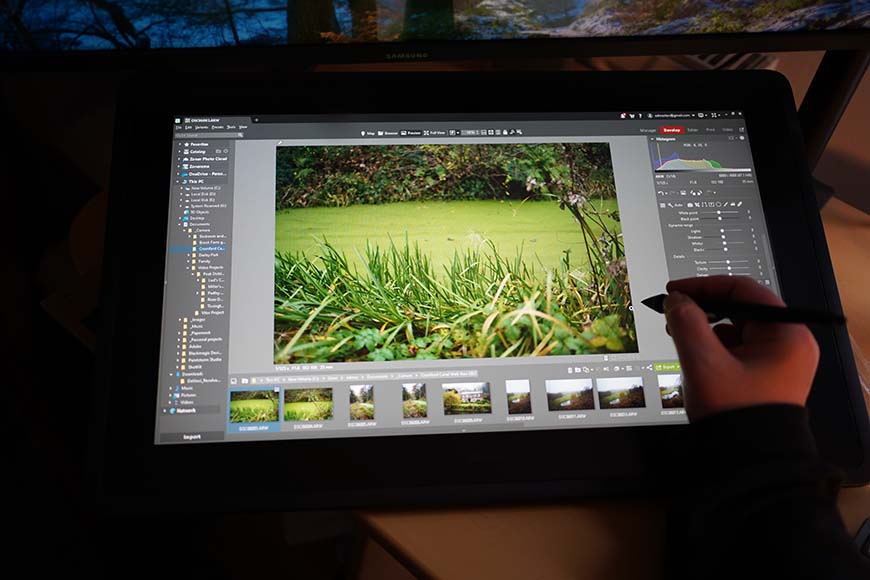

The user interface may not break new ground, but its familiar style makes it easy for all types of users to adopt.
The ZS user interface follows a similar approach to UI design found in many contemporary photo editor packages.
Neat, white fonts are set on a grey background, with the system’s file browsing structure displayed down the left-hand side of the interface.
The core modules are located in the top right-hand corner of the screen, similar to Adobe Lightroom and other programs.
This makes it simple and intuitive for anyone familiar with photo processing programs, offering a shallow learning curve for beginners.
The following core tabs are available through Zoner Photo:
- Manager module: The digital asset manager. This module allows for importing images, browsing through folders, batch editing, metadata editing, and searching through your archive.
- Develop module: This module provides access to core image-processing functions such as exposure adjustment, white balance, and color controls in a non-destructive manner.
- Editor module: A bit-map editor module contains more in-depth tools, allowing users to work with layers and masks, and contains functions for advanced manipulation of a picture.
- Print module: This user-friendly module allows you to optimize photos for printing in various formats and create other physical items from your work.
- Video module: A neat additional feature not typically included in photo programs, this covers basic video editing processes for content creation.
With its simple yet effective use of tabs and clear icons, the overall feel of the user interface is pleasing to work with.
File Imports and Organization
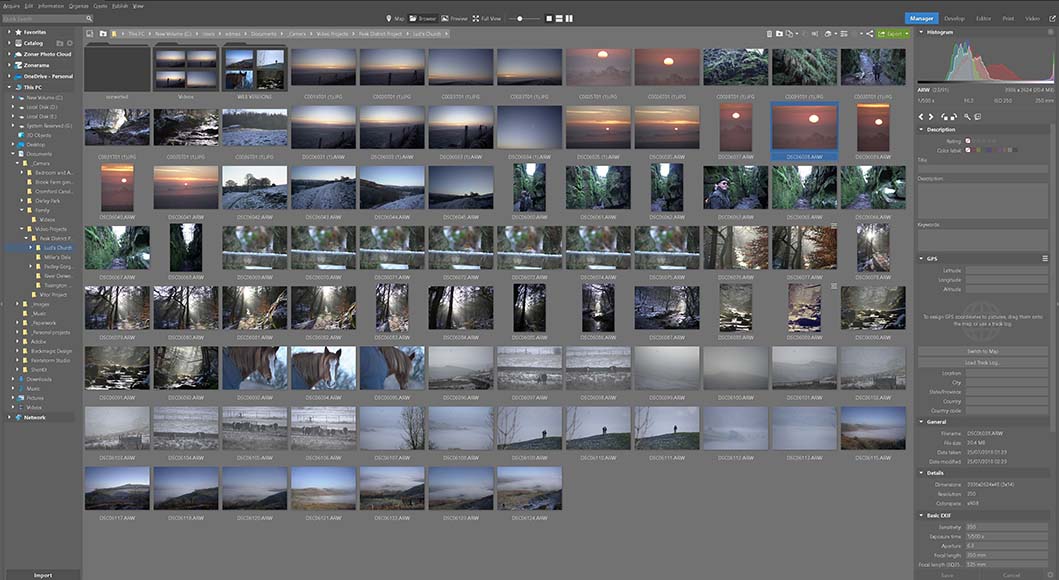

Zoner Studio’s ability to read straight from computer folders is a welcome addition for photographers who are used to importing their images.
With many photography programs requiring users to import all images, it’s refreshing to see Zoner Studio allow for instant access via your system’s folder tree.
There’s also an Import button for quickly accessing images from an SD card or other external drive. Import times are generally fast.
Once images are in the system, Zoner Studio offers a comprehensive range of options for naming bulk images and applying tags.
Metadata tagging, GPS-based location data, and a useful histogram display, combined with the image’s EXIF data, are also present.
It includes a star rating system for quickly assessing and categorizing new images and making the culling process run smoothly.
Users can also apply color labels to speed up their image categorization workflow when handling larger projects.
Imported images are displayed via a film strip along the bottom of the page, with options to view images in various formats, such as full screen.
As the Zoner Studio platform has evolved, additional RAW-camera support has been introduced to satisfy a broader range of photography gear.
Additional improvements have also enhanced the reliability of the histogram tool, as well as the Manager’s preview performance.
Post-Processing Image Development
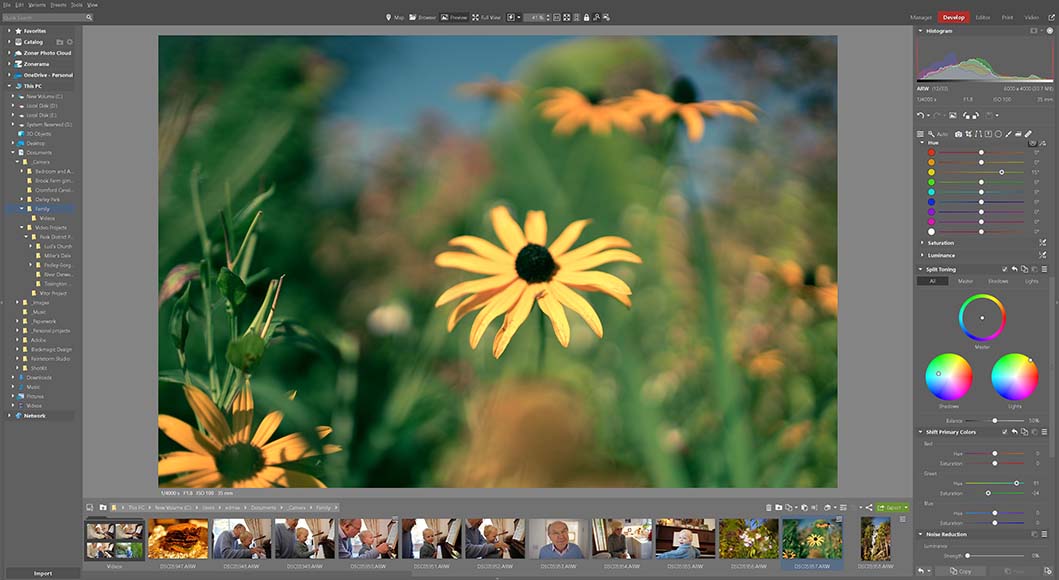

Great auto settings are complemented by everything from lens profiles and noise reduction tools, delivering impressive results.
Once photos have been selected in the Manager module, it’s time to head over to the next module tab to begin developing the photographs.
In the Develop module, users are presented with the core editing tools commonly used for post-processing, including white balance, contrast, saturation, and exposure.
There’s also a surprisingly effective auto-enhancement tool that hobbyist photographers can use to prime their images in a single click.
Additional presets enable users to apply a range of aesthetic choices to their photos, initiating the post-processing workflow.
These presets, which display in a pop-out menu to minimize overall interface clutter, cover an impressive range of styles.
The availability of 3D LUTs further expands the creative options for expressive photography that can be achieved using Zoner Studio.
Perhaps most impressive is the software’s selection of color adjustment tools, which cover everything from tone curves to split toning.
Featuring a color shift tool with adjustable color wheels, these offer precision when enhancing local adjustments not found in alternative software.
Zoner Studio also features a powerful Luma curve adjustment tool that can be used to bring more contrast and depth to images.
Additional tools, such as noise reduction, sharpness adjustments, and effects such as vignetting, round out an overall broad-ranging suite.
The combination of these features results in a truly impressive Develop module that stands up against the best alternatives on the market.
Covering features that aren’t available in Lightroom, it’s one of the flagship features that make Zoner Studio such a compelling Lightroom alternative.


Zoner Studio’s extensive selection of AI masks delivers reliable and accurate results for subjects, objects, and backgrounds.
Zoner Studio’s Spring 2025 update introduced several significant additions that utilize AI technology to streamline workflows.
The first of these additions is the AI Masking tools, used in the Develop module for masking and making local adjustments.
In terms of accuracy, these masking tools are highly capable, whether dealing with bold sections of images or more complex subjects.
There are also dedicated masks for color range and luminance range, both of which can significantly speed up workflows.
Additional AI masks featured in Zoner Studio, which can be used in the Develop and Editor modules, include:
- AI Background: Beneficial for portraits and other shoots where backgrounds require isolation, Zoner Studio’s tool delivers reliable masking results.
- AI Subject: Zoner Studio’s subject masking is also fast and accurate, particularly when combined with manual processes to refine edges or used in conjunction with other masks.
- AI Object: If you’re photographing products for a review, the AI Object masking tool can be used on single or multiple objects. All of these AI tools can help you quickly identify subjects and objects in your photograph and eliminate the need to zoom in and hunt around to check if everything is actually in focus.
- Batch masking: Another time-saving feature of Zoner Studio is batch masking, which allows created masks to be instantly applied to a series of photographs.
For instant results, Zoner Studio’s AI Automatic Enhancement tool delivers impressive improvements to images in a single click.
Masks aren’t the only feature to benefit from improvements; an extensive selection of local adjustment sliders is also available for refining results.
These can be used to lighten or darken subjects, backgrounds, and skies, as well as radial gradient adjustments for faces, eyes, and mouths.
It’s a comprehensive upgrade that enables rapid and precise photography development at both the macro and micro levels.
Image Local Adjustments and Layers


Zoner Studio isn’t going to sway long-time Photoshop users, but there are plenty of tools here for photographers looking for an affordable alternative in the bitmap genre.
Unlike many other mid-budget photography programs on the market, Zoner Studio includes various layer and effects tools for users.
These tools, located in the Editor section of the tabbed interface, cover a range of selection tools that help make Zoner Studio great value for money.
Magic wand selection and various shape-based selection tools are available and can be fine-tuned across several parameters.
Working with layers in the editor tab is also intuitive, with the layer masking workflow being the only area that requires a bit of head-scratching to achieve.
Zoner Studio also includes an impressive Liquify tool that’s responsive and offers great results for portrait photographers.
Combined with an effective red-eye reduction tool, Zoner Studio is an attractive proposition for photographers in that field.
There’s also a fun Lens Flare feature with plenty of configuration options to control aspects, including light spots, rings, and halos.
Additional tools include clone stamping, dodge and burn, and a customizable brush tool with pen pressure settings for drawing tablet users.
These layer-based tools are generally responsive, delivering impressive results that are typically comparable to those of Adobe products.


Automatic AI enhancements are handy for achieving quick results when you don’t have time for in-depth manual processing.
The same robust approach to image development afforded by the AI masking tools naturally extends across the platform’s extensive editing tools.
Having previously responded to user demands by incorporating layer support for compositing, they’ve now applied AI to enhance usability further.
The Editor module’s background removal feature is a welcome addition, saving potentially hours of manual selection work in post-production.
Once the AI has completed the background removal process, it can be easily replaced with a solid color or set to transparent as a PNG file.
Zoner Studio’s AI editing tools include automatic enhancements, featuring impressive scene analysis that enables one-click improvements.
This feature analyzes the image and provides updated versions with customized exposure, color, and contrast, often yielding visually striking results.
Additional AI tools have also been introduced to assist with portrait photography, notably the many AI portrait presets.
These tools can be used to automatically detect faces and apply local adjustments to facial features, such as eyes, mouths, and skin tones.
It also extends to the Manager module, utilizing facial recognition and close-up comparisons to streamline library management.
For example, you can use the tool to detect out-of-focus shots, as well as identify and remove shots with the subject’s eyes closed.
Considered as a whole, the new AI tools cover all bases, facilitating processes for both casual photographers and seasoned professionals.
Recent updates further improve the overall stability and accuracy, along with subtle improvements to retouching algorithms.
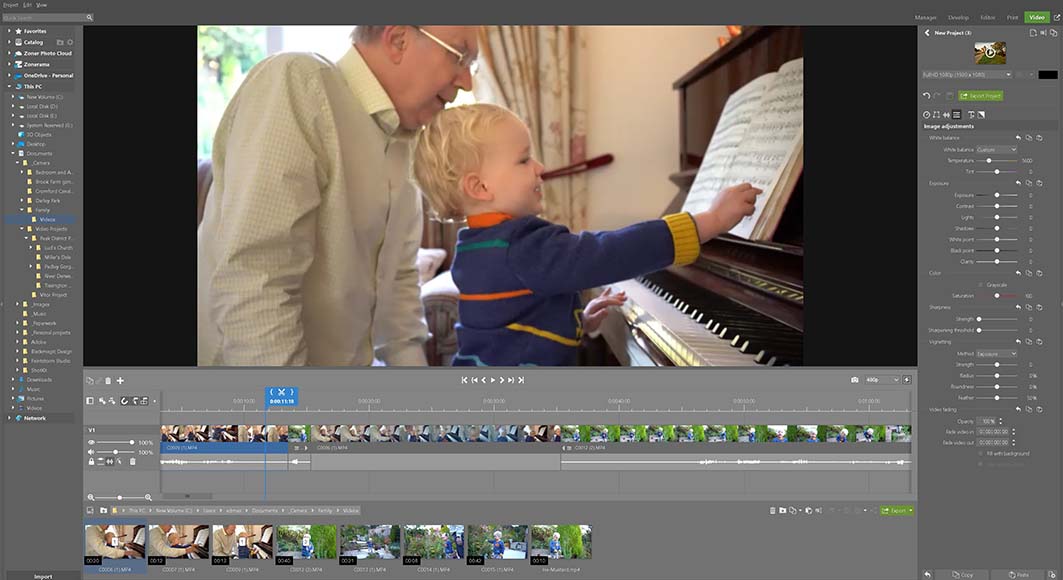

In addition to an impressive selection of photography tools, Zoner Studio includes a fun and robust video editor.
The last of the main modules included with Zoner Studio is the video module, a feature rarely included in comparable photography software.
This video editor offers an effective set of editing tools, featuring a familiar drag-and-drop timeline and interface.
Clip navigation is easy, with clear icons to help users edit and rearrange clips into the order they require.
The same array of image adjustments found in the photo editor is also available here, ranging from adjusting exposure to vignetting and sharpening.
Video-specific tools also include a nice fading feature and a selection of the more popular transitions for content creation.
To help add visual interest to your content, you can choose from crossfade, dip to black or white, and various shot sliding transitions.
Additional text options included cover titles, credits, and subtitles, along with an option for metadata to optimize online content.
Similar to the photography features, the Video module has undergone a series of welcome enhancements in recent updates, elevating its functionality.
Keyframes and transport controls are excellent for introducing elements of animation and transforming clips for more energetic editing.
Clip preloading improvements further enhance these features, with minimal delays when adding shots and generally faster preview performance.
Combined with multi-monitor and ultrawide monitor support, this is among the major upgrades users had been calling for.
The addition of 3D LUT support is another core update that elevates the Video module above and beyond its previous capabilities.
Opening up opportunities for low-cost color grading and experimentation, this feature can benefit both photographers and video content creators.
Likewise, the extensive list of RAW camera support is advantageous to videographers seeking a one-size-fits-all platform for photo and video editing.
While the video editor isn’t likely to compete with dedicated software like DaVinci Resolve Studio or Adobe Premiere, it’s shaping up to be a competitor.
It’s also a nice additional touch for photography-first content creators who may want to produce short videos alongside their image content.
Overall Performance
The software experiences minimal to no delays when large volumes of RAW image files are loaded into the system and prepared for editing.
This overall satisfying performance speed is enhanced thanks to the platform’s intuitive and neat user interface.
The user experience is generally impressive, with menus and subcategories easily accessible and integrated into a logical workflow.
Zoner Studio also includes a handy photo benchmark that can help you evaluate your computer’s speed.
I found that some slight delays occurred when adding 4K video clips to the project timeline, but these were negligible and didn’t significantly impact the workflow.
The ability to create original presets for a wide range of functions, from post-processing to exporting, also enhances overall performance.
How I Tested Zoner Studio
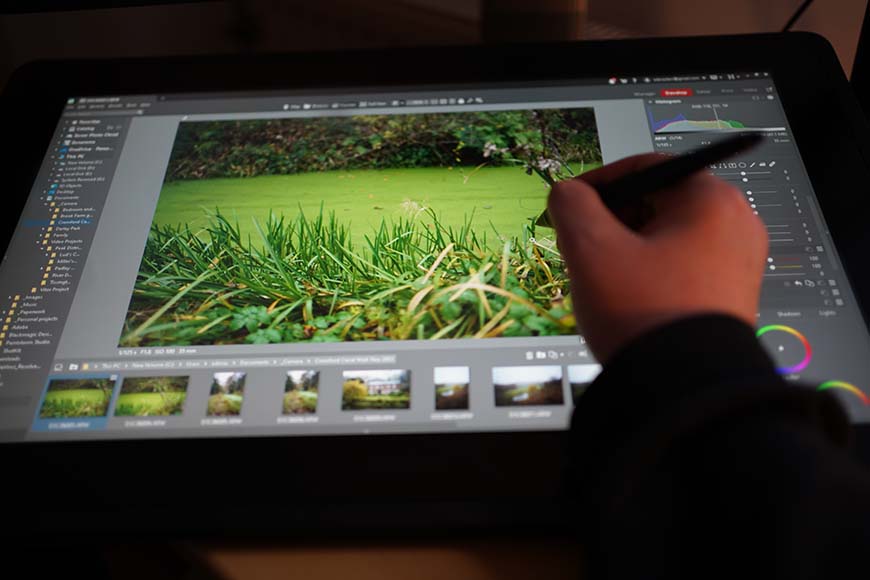

Zoner Studio includes pen optimization options for enhanced performance through graphics tablets.
The Zoner Studio photography software comes with recommended specifications, including 4GB RAM with at least 1GB of available space.
For this review, I tested the photo editor using an AMD Ryzen 5 processor with a graphics card and 32GB of RAM, and found it to be consistently smooth.
I tested the file management and browsing features with bulk image inventories and encountered no issues loading image previews.
All post-processing features were also tested on various images, with the photo editing platform consistently delivering reliable results.
For the more advanced features, I optimized a selection of images based on various parameters to assess the quality of raw processing.
I also compared the performance speed of Zoner Studio to other photo editors and found it to offer comparable results.
Alternatives to Zoner Studio
There are several viable alternatives to Zoner Studio on the market at a range of price points and feature options.
The most obvious alternatives, widely used by professional photographers, are Adobe Lightroom and Photoshop, albeit at twice the price.
Adobe’s photo development and editing tools are more comprehensive, including some AI-powered features that are not yet available in Zoner Studio.
If you’re looking for other software for editing RAW photos, RawTherapee has plenty of photo editing tools you can use for free.
Affinity Photo offers comparable photo editing tools while avoiding the subscription model that deters some photographers from Adobe and Zoner Studio.
For general photo management covering location data and cloud storage, ACDSee Photo Studio has a large user base of photographers.
It also supports layer editing and features a Develop module, but lacks the in-depth editor module found with Zoner Studio.
Value for Money
Coming in at roughly half the price of a monthly subscription to Adobe’s Creative Cloud photography suite, Zoner Studio represents a significant saving.
With updates that bring on board a raft of AI features, the platform gives its closest rival a serious run for its money.
Additional much-needed improvements to the Video module also make this a compelling option for content creators in both spheres.
If you’re a YouTuber or influencer, the ability to effortlessly manage and edit images and video on the same platform is a huge drawcard.
A 7-day free trial option allows users to try before they buy, experiment with the included tools, and assess the workflow.
Perhaps the biggest draw for Zoner Studio is its combination of cataloging, developing, and editing of raw files.
By rolling these processes into a single photo editing program, photographers can work on non-destructive editing and exporting in a single space.
Zoner Studio Review | Conclusion
Zoner Studio is a highly appealing alternative to mainstream photo editors such as Lightroom and Photoshop, offering several compelling reasons to adopt it.
It’s affordable and reliable, blending raw development tools, in-depth image editing, and a fun, if somewhat limited, video module for content creators.
The company’s commitment to rolling out new features twice a year is another good incentive for investing in the platform over the long term.
They also offer customers a free in-house online magazine called Learn Zoner, weekly YouTube uploads that explore tips and inspirational advice on getting the most out of their tools, and an unlimited online gallery with a plethora of options to store or share your content called Zonerama.
While seasoned professionals are unlikely to abandon Lightroom and Photoshop, photographers seeking to streamline their workflow will find plenty to appreciate about Zoner Studio.
Highly Recommended

Photo organizer and editor with powerful editing tools, a user-friendly interface, and video editing capabilities.
Credit : Source Post





